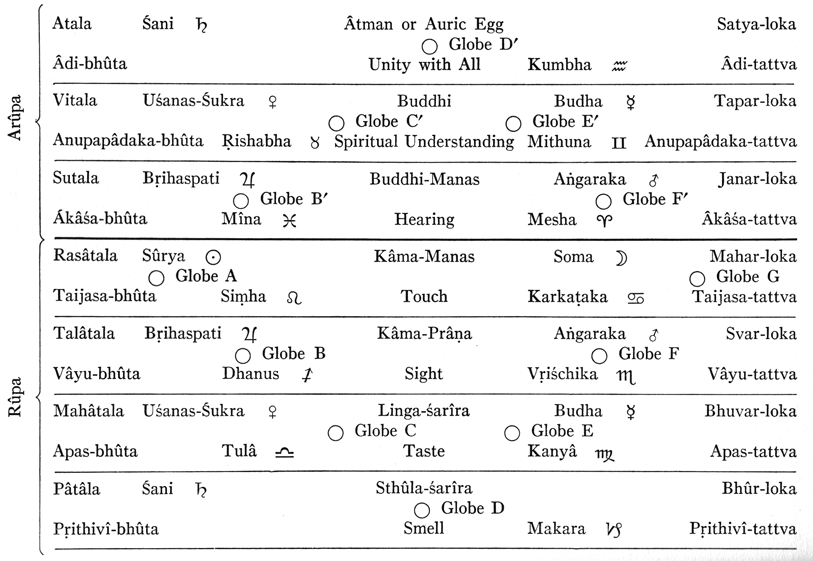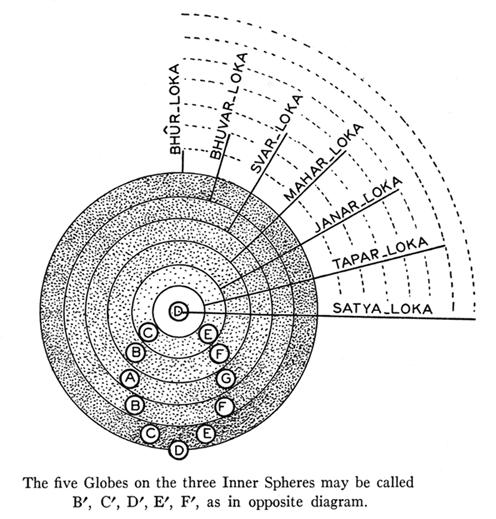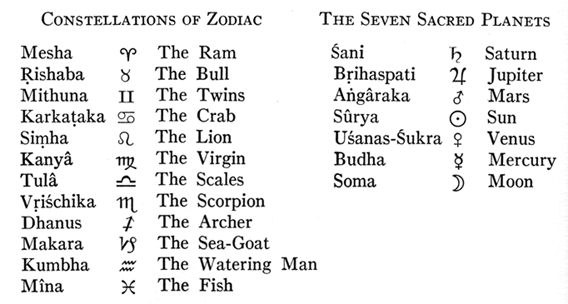
Sanskrit Terms from Fundamentals of the Esoteric Philosophy

The Ancient Wisdom teachings divide the Universe into seven great Planes or worlds of beings, each of which is bi-polarized into a Loka and a Tala. These pairs of Lokas and Talas are as inseparable as the two sides of a coin. They represent those two universally contrasting forces of nature which are expressed by good and evil, high and low, spirit and matter, etc. The word Loka means "a vast space," "a world," and is applied to a spiritual sphere. The seven Lokas are called in Hindu writings the "seven regions of the blessed" or the "seven heavens." The word Tala means "lower part," "base," and is applied to a material place or region. The seven Talas have been called the "seven Hells" or the "seven inferior places."
Each couple of Loka and Tala represents a cosmic plane, or rather a sphere ranging from its loka or spiritual parts to its tala or physical parts. The highest and most spiritual and inmost of the lokas and talas produces the next lower or next outer loka and tala, which in its turn contains within itself the qualities of its parent and of the lokas and talas beneath or without it as well as its own dominant characteristic qualities. So on down to the lowest or outermost loka and tala. Therefore we see that each loka and tala is sevenfold, and contains aspects of all the other lokas and talas within it or without it.
These lokas and talas represent different stages in evolutionary unfoldment. All evolution may be described as a series of spirals. Beings, in order to evolve, come forth from the Great All, the Divine Source, and then descend along a series of spheres, each more material than the preceding, and on each of these they build for themselves bodies in which to live. When they reach the lowest point of the descent, the most material sphere, they then proceed upwards to unfold consciously the spiritual and inner beauty latent and wrapped within their bodies of different degrees of physical texture. As they advance upwards they cast aside their garments gradually, the most material first, and become more and more divine in manifested virtue and power, until they reach once more the highest, the Divine Source, but not in the same condition as that in which they last sprang forth from it, but on a higher level, wiser, grander, and more universal. There they rest for a while until the urge to become greater brings them once more into manifestation. The coming forth into manifestation, the putting on of garments, each one more material as the descent continues, is another way of saying that a man, or any other being, passes through the tala-side of the seven great divisions of the Universe. The conscious return to the Divine Source, the unfolding of the divine qualities and the casting off of the material forms of different grades, is another way of saying that a man, or any other being, is passing through the loka-side of the seven great divisions of the Universe. Hence Theo-sophy teaches that as a human Life-Wave comes into being on this Earth it passes around or through the twelve Globes of the Earth's Planetary Chain which are distributed over the seven Great Cosmic Spheres or planes. There is one such Globe on the highest and lowest planes, and two such Globes on each of the planes between. (See accompanying diagram.) Hence as the Human Race appears, it passes from Globe D" to C to B" to A to B to C to D on its Descending Arc into matter, and as it does this, on each Globe it builds for itself bodies appropriate to the sphere through which it passes. This descent through the globes is actually a passing through the seven Talas of the Universe. Then from the midpoint of the cycle of time passed on Globe D the Human Race ascends upwards, passing from Globe D to E to F to G to F" to E" to D'. This ascent through the globes is actually a passing through the lokas. This same tala-descent and loka-ascent may be applied analogically to anything that evolves, from atom to universe.


The diagram to the left shows these lokas and talas and the Globes of the Planetary Chain in planes one above the other. This diagram, though useful in showing corresponding aspects in several hierarchies, can be misleading. The circular diagram above is more nearly correct. But these circles representing the lokas and talas must not be considered as flat geometric planes, but as spheres with a common center lying one within another The inmost, which is the most spiritual and ethereal, penetrates all the other spheres, and goes far out beyond them all, whereas the outermost Loka-Tala, though permeated by the influences and atmospheres of all the other lokas and talas, does not itself reach beyond its own atmosphere
We thus see by observing the circular diagram that every one of the lokas and talas is sevenfold and that though each pair is permeated by the six others, it has its own essential and dominant characteristic. This demonstrates the truth that at any moment, right here on earth in the Bhurloka-Patala in which we at present live we may penetrate the depths and inner spiritual parts of ourselves and our sphere and commune with our higher Selves and our Spiritual Guardians. We must become fully conscious in all the lokas and talas and sub-lokas and sub-talas before we truly know the Universe and ourselves.
The unconscious descent through the talas, into matter, is the first and necessary process of evolution, a process which prepares the way for the second and most important half of the evolutionary journey, that of the conscious ascent through the lokas, the self-directed unfoldment of the lofty inner qualities and powers. The Human Race is now in this second stage of development, because it long ago reached Globe D, the nadir of the descent. Therefore the different bodies, physical, astral, mental, and spiritual, with which we have clothed ourselves in our descent, should now be kept pure in order that they may be used as sacred instruments on that self-directed spiritual journey upwards. The first descent through the talas is not evil, is not against nature's laws; but a second and conscious descent through the talas, brought about by the choosing of that which is low and the self-willing identification with matter and its limiting and selfish attributes, is evil, for it is against nature's laws. This latter is the Downward Path to annihilation, the path of a Lost Soul or of a Brother of the Shadow.
So we may say that the tala-side of nature has its two poles, its two contrasting aspects, the good — that which enables beings to build forms on their descent into existence; and the evil — that of self-identification with the base and selfish side of nature. Likewise the lokas have this dual aspect, which is demonstrated in the Path of the Buddhas of Compassion and the Path of the Pratyeka-Buddhas. (See Lesson II.)
Though these lokas and talas may be depicted as states of consciousness or conditions of beings they are also actual localities in which different classes of beings, high, intermediate, and low, live. The particular meaning of each set of loka and tala beginning with the highest is as follows:
Satya-loka is the "world of truth and reality," the realm in which live divine beings and Nirvanins. It is the highest state of consciousness possible to a human being, the loftiest Samadhi. Its atmosphere extends into regions far beyond our ken, out into the fields of infinitude. Its nether pole, Atala, is the first suggestion of a place, the first something of existence. It is called a-tala, "not-a-place," because it is of such spiritual-ethereal matter that it can scarcely be considered a place. A Lost Soul or one who follows the Downward Path, suffers final annihilation in Atala.
Tapar-loka is the "world of spiritual meditation and devotion," the realm in which live the Spiritual Guardians of our Universe, the state in which the Christos or the Buddhic Splendor manifests itself in its fulness. Its atmosphere, though not as far-reaching as Satya-loka, extends beyond our ken. Its nether pole, Vitala, is that spiritual-ethereal place in which there is a change (vi) towards matter, therefore it is a "better place for matter." It is in Vitala that the one who self-consciously following the Downward Path breaks the final link with his Higher Nature.
Janar-loka is the "world of spiritual birth," the realm in which dwell the Kumaras, Agnishwattas, and Manasaputras, the state in which the Higher Manas of man becomes the complete master of the lower principles. Its atmosphere extends to the reaches of our Galaxy. Its nether pole Sutala is a "good place," that is, a place that is good (su) for matter. In Sutala a human being who has selfconsciously followed the Downward Path has brought his mind into the condition of an absolute slave to his lower desires.
Mahar-loka is the "great world," whose field of influence extends to the limits of our Solar System. It is the realm in which live the different classes of Devas who are intimately connected with the mind and the senses. In this loka a man's brain-mind is no longer deluded by Maya, but is concerned with compassionate service to all. The nether pole, Rasatala, is the "place of taste," that place in which one can perceive with one of the organs of sense. A human being whose brain-mind is wholly concerned with things of the senses and the objective world is immersed in Rasatala.
Svar-loka is the "heaven world" wherein the human being enjoys the after-death state of Devachan. It is the state in which a human being unfolds his higher aspirations. It is the abode of the higher Elementals, and its atmosphere extends to the pole star. Its nether pole is Talatala. This word is a compound of tala-atala, meaning "a place not a place" and implying that this place is more of a tala than those above it but is not yet a fully substantial tala. A man who centers his mind and energies in the gratification of his senses is in Talatala.
Bhuvar-loka is the "world of becoming," the region of the Astral Light which extends to the Sun, and the abode of the lower Nature-spirits. A man who has attained to this Ioka has become aware of his inner and higher nature and hence has become more impersonal, and therefore more unselfish, more spiritual. The nether pole of Bhuvar-loka is Mahdtala, the "great place/ the abode of man's astral shadow. When a man performs deeds which are selfish and unkind and impure he is in Mahatala.
Bhur-loka is the "earth sphere" in which our planet Terra or Globe D exists. It is the abode of human beings who are thoughtful and good, but not necessarily spiritually awakened. Bhur-loka's nether pole is Patala or the "nethermost tala" or the region beneath us, the Underworld. The derivation of Patala is obscure, but it may be a contracted form of pata — sunk or fallen, and tala. Patala is the dwelling-place of man's physical body and personal self, of animals, and of Nature-spirits such as the gnomes. Instinctual selfishness, self-preservation, gratification of the senses, and the helpless innocence of childhood are characteristic marks of one who is in Patala. Patala is often used for our word "Hell."
Such are the ranges of the Human Spirit: from the darkest regions of Patala to the loftiest and divinest regions of truth — Satya-loka!
Arupa Rupa is body or form. Arupa, a compound of a — not, Rupa and rupa — body, is applied to something without form or body. The three highest of the Lokas and Talas and the five higher Globes of the Planetary Chain are called Arupa, not because they have no material form, but because to our physical senses they would appear as formless. The four lower Lokas and Talas and the seven lower Globes are called Rupa worlds and Globes because their bodies are of a substantial nature more like unto our own.
Tattva Mahabhuta The word Tattva means the "reality" or "that-ness" (tat-tva) of a thing. The seven Tattvas are the Principles or Essences of the Cosmos, the conscious and directing forces, the sources of the manifested Elements or rudimentary stuffs of the Cosmos, which last are known as the Maha-bhutas or the "Great has-beens." These great Elements are not the earth, air, water, and fire we perceive here; these latter are but presentiments of these great Maha-bhutas. The two highest of these Tattvas and Bhutas are not as yet recognised by humans, but will be in future ages. Taijasa and Apas are the adjectival forms of tejas — fire, and apas — water.
Like the Lokas and Talas, each Tattva and Bhuta gives birth to the Tattva and Bhuta below it and retains a portion of all the other tattvas and bhutas within it and yet manifests its own dominant characteristic. Each Tattva has a corresponding Bhuta of the same name. Below are the seven Tattvas with their meaning:

Not only do the seven Lokas and Talas have their correspondences with the seven Tattvas and Bhutas and with the twelve Globes of the Planetary Chain, but they likewise correspond to the seven principles in man (see Lesson I), and also to the development of the seven senses, as shown in the large diagram. Just as two of the Cosmic Elements are as yet unknown to us, so are two of the senses. Intuition, a harbinger of the sense of Spiritual Understanding, is just beginning to be recognised. As the ages roll by and the Sixth Race men appear, this spiritual sense will become more and more evident. In order to explain the planets and Constellations of the Zodiac, as given in the large diagram, I quote from Dr. de Purucker's Fundamentals of the Esoteric Philosophy, page 488:
There is a strict and close correspondence between each of the seven Sacred Planets and one of the globes of our Earth-Chain, respectively; and between each one of the globes and one of the constellations of the Zodiac — one of the Houses of the Circle of Life, as the Greeks called it. But while it is true that the Seven Sacred Planets of the ancients, Saturn, Jupiter, Mars, the Sun (as a substitute for a secret planet), Venus, Mercury, and the Moon (as a substitute for another secret planet), do actually build and oversee our Planetary Chain as a whole (one of the Sacred Planets respectively to one of the Globes), nevertheless while the influences of the other six of the Seven Sacred Planets are at work therein also, yet the one predominating power over each globe comes from its especial sacred Planet. Likewise, under the particular oversight, or overseeing, of one of the constellations of the Zodiac, that is to say of the predominating Genius or Rector of that constellation of the Zodiac, nevertheless each one of the other eleven constellations is also at work in each of the twelve globes of the Chain. There can be no separation of forces, for everything works together in Nature towards a common end — which is one of the noblest proofs we have of our doctrine of Universal Brotherhood.
Below are the Sanskrit and English names of the seven Sacred Planets and the twelve Constellations of the Zodiac:
